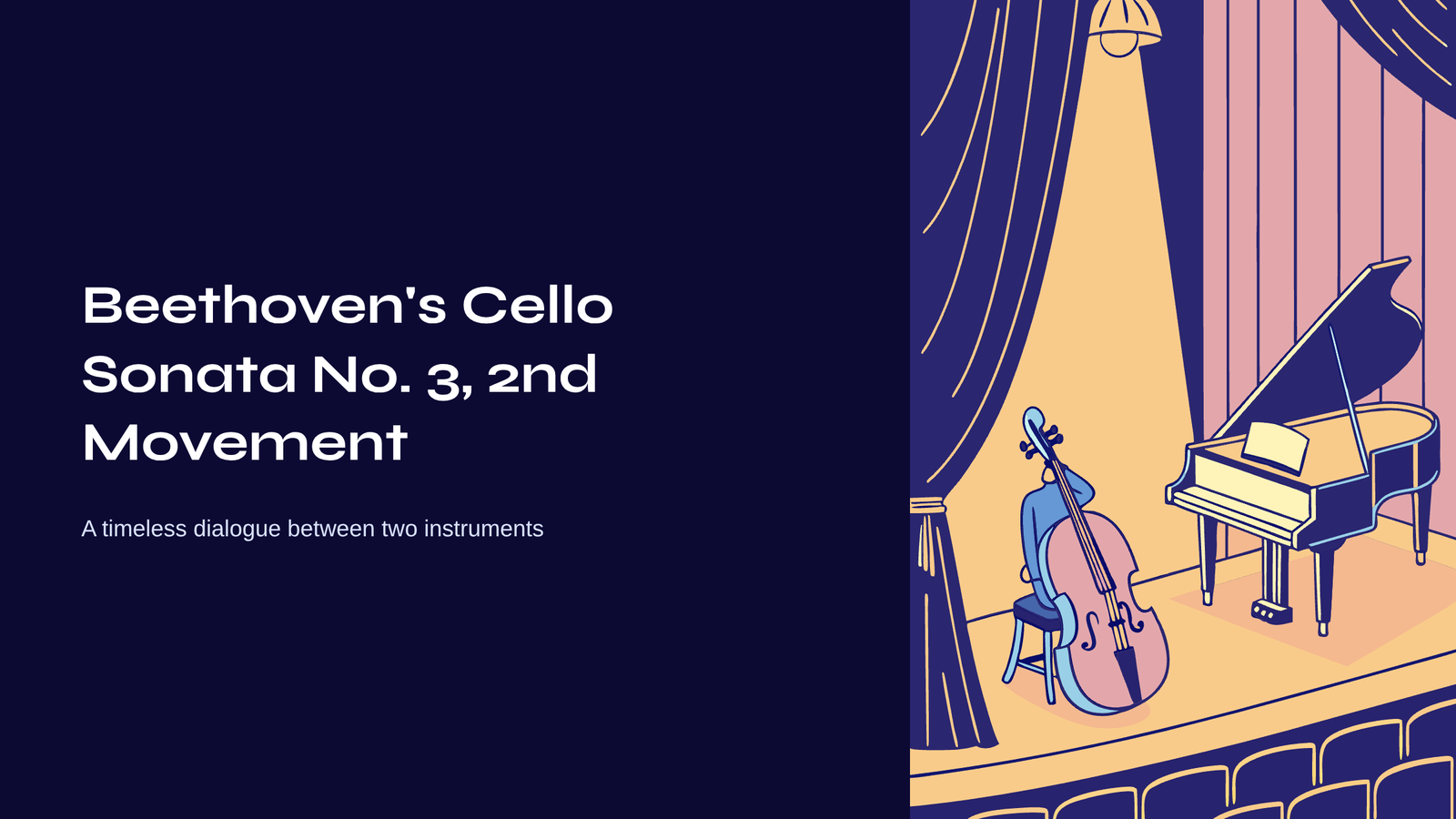Table of Contents
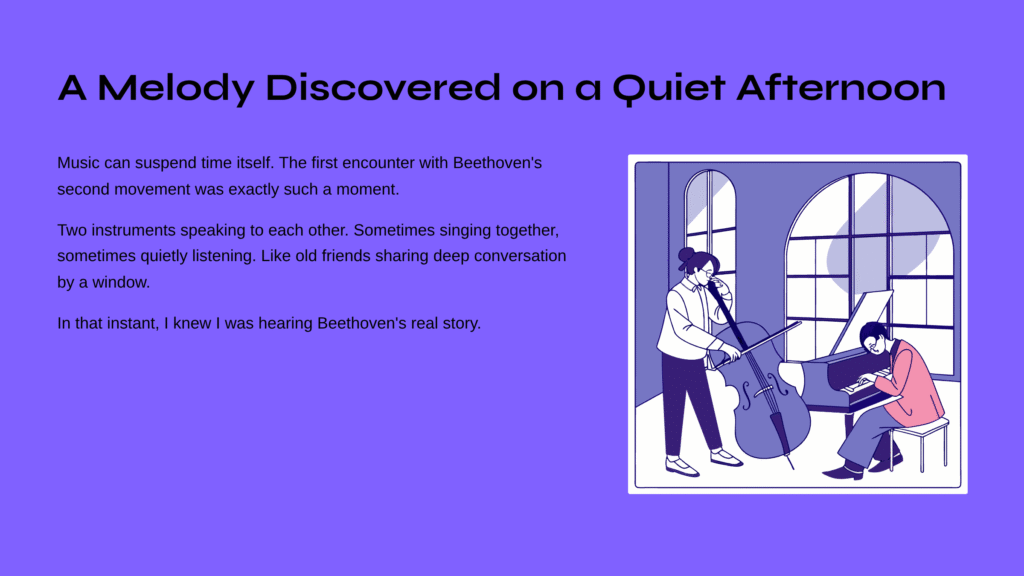
A Melody Discovered on a Quiet Afternoon
There are moments when music seems to suspend time itself. The first time I heard the second movement of Beethoven’s Cello Sonata No. 3 was exactly such a moment. As the cello’s profound voice met the piano’s gentle whispers in conversation, I knew I was witnessing the very magic that music possesses.
Two instruments speaking to each other, sometimes singing together, sometimes quietly listening to one another’s stories. It felt like watching old friends sitting by a window, sharing a deep conversation. In that instant, I became certain that I was hearing the real story Beethoven wanted to tell us through this music.
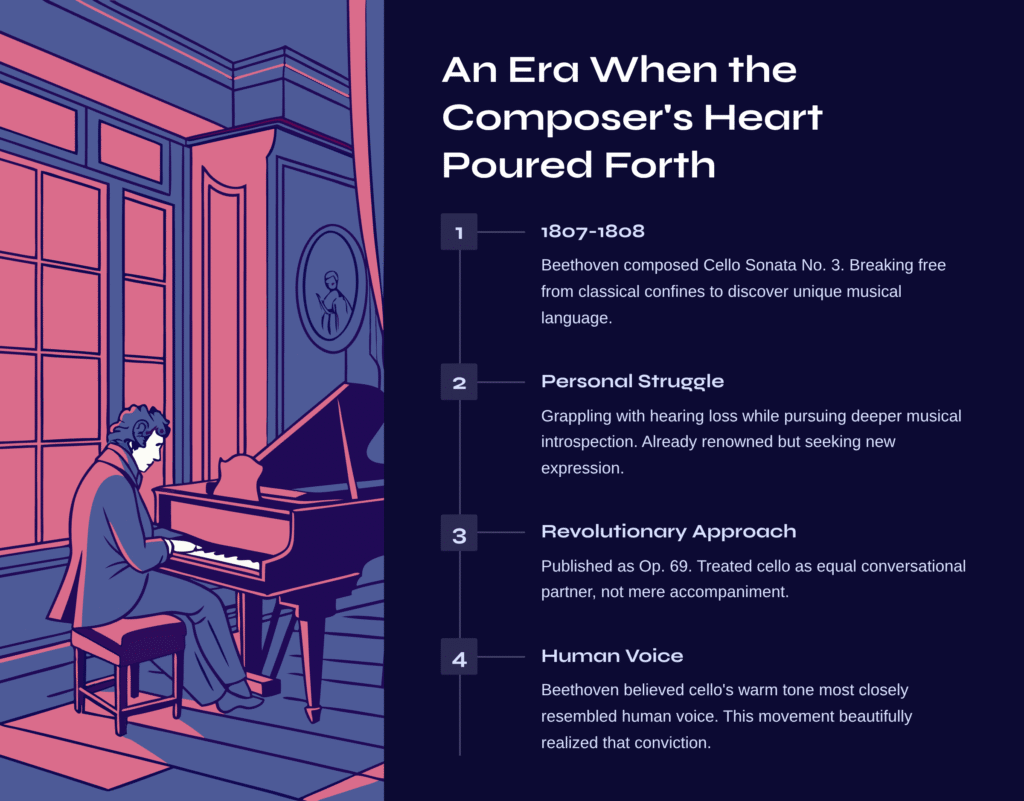
An Era When the Composer’s Heart Poured Forth
The years 1807-1808, when Beethoven composed this Cello Sonata No. 3, marked a special period in his life. It was a time when he was breaking free from the rigid confines of classicism to discover his own unique musical language. Though already a renowned composer, he was also grappling with personal anguish from his hearing loss while pursuing deeper musical introspection.
Published as Op. 69, this work represents Beethoven’s masterful discovery of the cello’s new possibilities. His treatment of the cello as an equal conversational partner to the piano, rather than merely an accompanying instrument, was revolutionary for its time. Beethoven believed that the cello’s deep, warm tone most closely resembled the human voice, and in this movement, he beautifully realized that conviction.
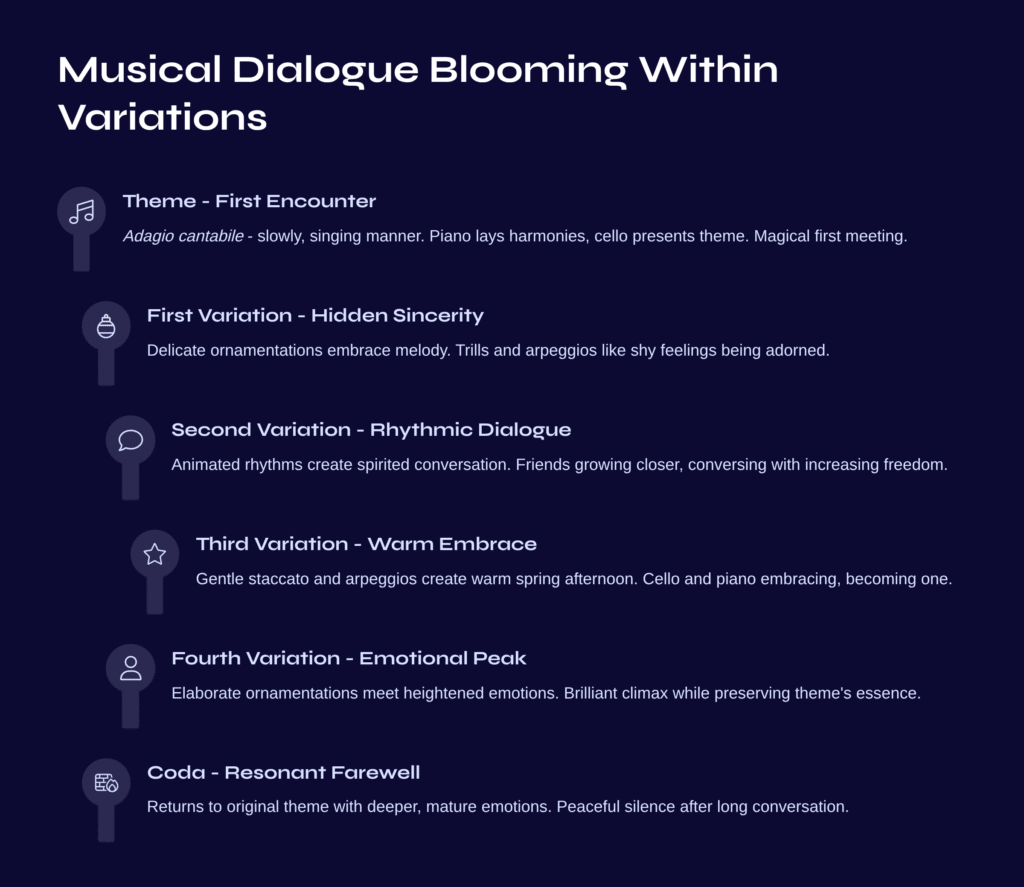
Musical Dialogue Blooming Within Variations
Theme – The Excitement of First Encounter
Adagio cantabile – slowly and in a singing manner. As the piano quietly lays down harmonies, the cello presents the theme. This moment feels truly magical. It’s like witnessing two people meeting for the first time, getting to know each other with that careful yet thrilling sense of discovery.
The theme itself appears simple, yet the depth of emotion contained within is remarkable. How can words capture the beauty of that moment when the cello’s inherent warmth blends with the piano’s gentle harmonies?
First Variation – Sincerity Hidden in Ornamentation
In the first variation, Beethoven adds delicate ornamentations to the theme. Trills and arpeggios embrace the melody like shy feelings being adorned. The cello reveals increasingly lyrical colors while the piano tenderly supports this expressive cello voice.
Second Variation – Dialogue Through Rhythm
The second variation brings slightly more animated rhythms. The spirited conversation created by eighth and sixteenth notes resembles two friends growing closer, conversing with increasing freedom. The cello and piano exchange the theme while exploring new musical ideas together.
Third Variation – A Moment Like Warm Embrace
The third variation is personally my favorite section. The atmosphere created by gentle staccato and the piano’s left-hand arpeggios feels like a warm spring afternoon. It’s as if the cello and piano are embracing each other while becoming one.
Fourth Variation – Emotional Climax and Brilliant Dialogue
In the fourth variation, the music reaches its peak. Elaborate ornamentations meet heightened emotions, creating an intense climax. Yet what remains quintessentially Beethovenian is that amid all this brilliance, the essential nature of the theme is never lost. No matter how ornate the decorations become, that original pure melody continues to flow underneath.
Coda – A Farewell That Leaves Resonance
In the coda, the music returns once again to the original theme. But now it’s the theme after having journeyed through all the variations. Though it’s the same melody, it carries much deeper and more mature emotions. It’s like the peaceful, warm silence that follows a long conversation.
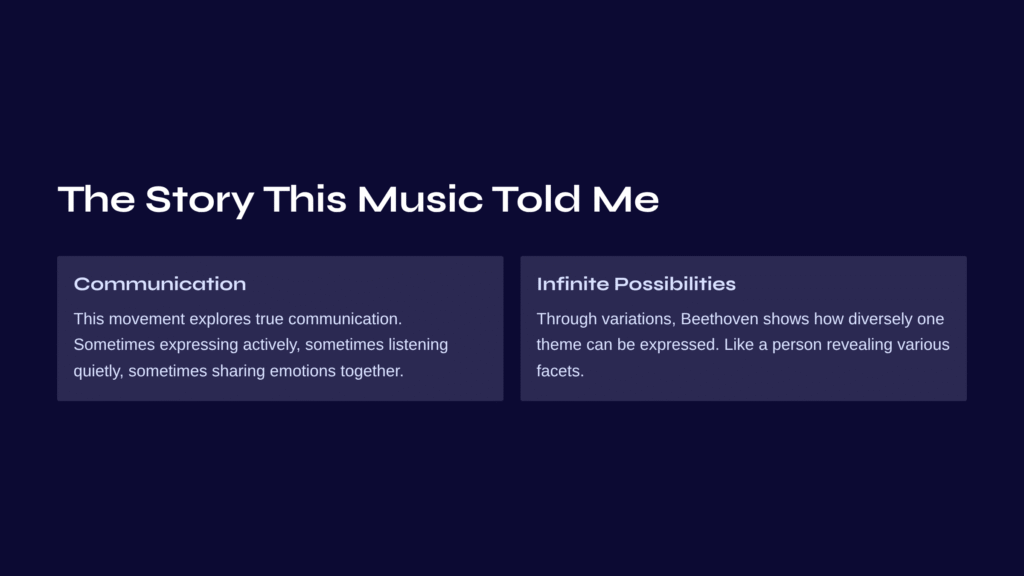
The Story This Music Told Me
To me, this movement is music about ‘communication.’ Listening to the dialogue between cello and piano made me reflect on what true communication really means. Sometimes expressing oneself actively, sometimes quietly listening to the other, sometimes sharing the same emotions together – all of this flows naturally within the music.
Particularly through the variation form, what Beethoven demonstrates is how diversely a single theme can be expressed. Like a person revealing their various facets one by one, I felt that music too holds infinite possibilities within a single theme.
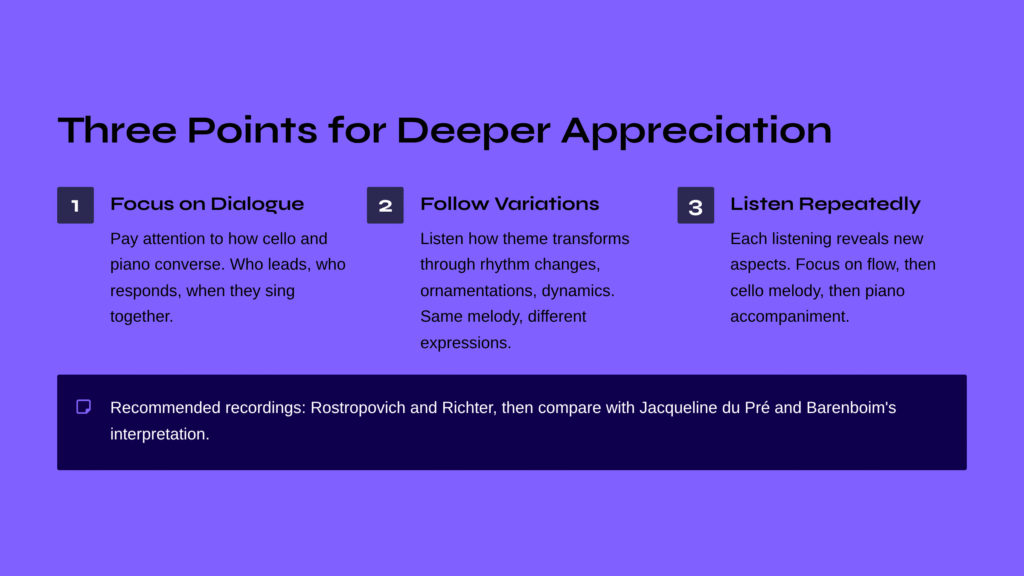
Three Points for Deeper Appreciation
First, Focus on the Dialogue Between the Two Instruments
When listening to this movement, pay attention to how the cello and piano converse with each other. Observe who leads the theme, who responds, when they sing together, and when each voices their individual part. This alone will make the music sound infinitely richer.
Second, Follow the Changes in Variations
Listen carefully to how the theme transforms. Through changes in rhythm, added ornamentations, and dynamic shifts, you’ll sense how the same melody can wear completely different expressions. I recommend starting with the Rostropovich and Richter version, then comparing it with Jacqueline du Pré and Barenboim’s interpretation.
Third, Listen Repeatedly
This movement reveals new aspects with each listening. Focus first on the overall flow and atmosphere, second on the cello’s melody, third on the piano’s accompaniment. The charm of this music lies in offering different emotions with each encounter.
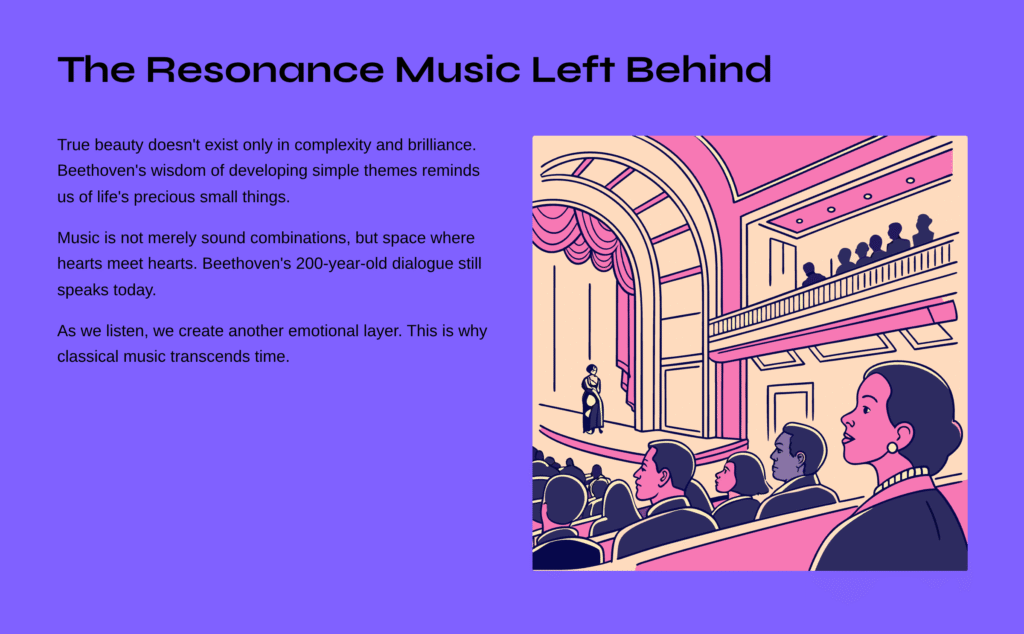
The Resonance Music Left Behind
What I felt while listening to Beethoven’s Cello Sonata No. 3, second movement, was that true beauty doesn’t exist only in complexity and brilliance. Beethoven’s musical wisdom of beginning with a simple theme and gradually developing it reminds us of the preciousness of small things in our own lives.
Listening to the dialogue between these two instruments, I realized that music is not merely a combination of sounds, but a space where hearts meet hearts. The dialogue Beethoven created 200 years ago still speaks to us today, and as we listen to those words, we create yet another layer of emotion. Isn’t this precisely why classical music transcends time?
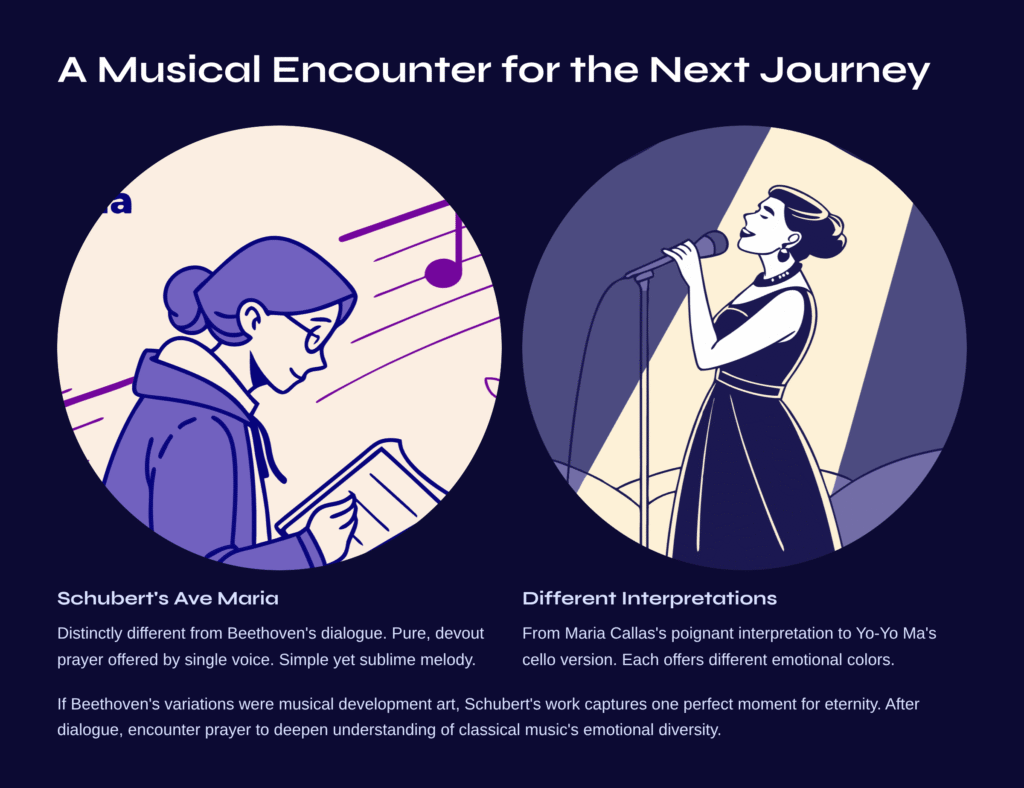
A Musical Encounter for the Next Journey
Having experienced the profound dialogue between Beethoven’s cello and piano, why not embark on another beautiful musical journey?
Schubert’s Ave Maria (Ellens Gesang III, D.839) offers a charm distinctly different from Beethoven’s chamber music dialogue. Composed by Schubert after being inspired by Walter Scott’s poem “The Lady of the Lake,” this piece has touched countless hearts with its simple yet sublime melody.
If Beethoven’s music was an intellectual dialogue between two instruments, Schubert’s Ave Maria is like a pure and devout prayer offered by a single voice. Originally composed for soprano and piano, it has been performed on various instruments including cello, violin, and organ, each offering different shades of emotion.
When listening to this piece, focus on the peace and comfort the melody provides rather than the meaning of the lyrics. Schubert’s characteristic lyrical harmonies and natural melodic progressions will seep into the depths of your heart. If Beethoven’s variations were the art of musical development and dialogue, Schubert’s work is the art of capturing one perfect moment for eternity.
I recommend experiencing different colors of Ave Maria from Maria Callas’s poignant interpretation to Yo-Yo Ma’s cello version. After Beethoven’s dialogue, encountering Schubert’s prayer will deepen your understanding of how diversely classical music can express human emotions.
